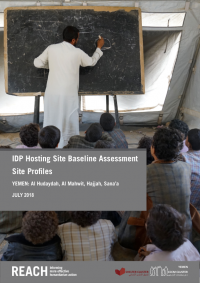Yemen: Al Hudaydah, Al Mahwit, Hajjah, Sana’a – IDP Hosting Site Profiles, July 2018
Introduction
The IDP Hosting Site Baseline Assessment aims to support targeting and response planning by humanitarian stakeholders, including authorities, UN agencies, and local and international nongovernmental organisations (NGOs). It provides a baseline of key multi-sectoral indicators across IDP hosting sites in 20 governorates, based on data collected through interviews with key informants in each site. The baseline assessment will help to inform the site management support which will be offered to the local authorities and humanitarian actors in charge of IDP hosting sites, as well as the support which will be offered to IDPs to establish self-governance, community participation, and communication processes within IDP hosting sites.
The IDP Hosting Site Baseline Assessment is organised and supported by the Shelter / NFI / CCCM Cluster coordination team and cluster partners. The data collection for the baseline assessment was carried out by the International Organisation for Migration (IOM) in 16 governorates and the office of the United Nations High Commissioner for Refugees (UNHCR) in 4 governorates.
Once the baseline of current sites is finalised, its updates will be carried out every six months to assess newly established sites. Monitoring of the sites identified through the baseline and its updates will also be carried out on a regular basis. The information generated over time through monitoring data collection will provide an indication of structural and sectoral changes in the conditions of the sites.
For the purposes of this assessment, REACH supports the Shelter / NFI / CCCM Cluster in data analysis and output production. The core outputs for this assessment include:
- Summary report: Overview of key indicators and comparative analysis of sites to identify those in most urgent need;
- Site Profiles: Produced for each site with relevant sectoral information;
- Site Maps: Maps showing site location and characteristics.
This report presents findings from four governorates – Al Hudaydah, Al Mahwit, Hajjah, and Sana’a – based on data collected in July 2018 by IOM during the fourth phase of the baseline assessment.
The first three phases of data collection took place in sixteen governorates, in June 2017, August 2017 and September/October 2017.
Methodology
The assessment was conducted in four stages across 20 governorates, in IDP hosting sites of five or more IDP households, where assistance and protection services can be delivered collectively. To identify sites, TFPM Area Assessments1 and a Cluster site list have been used. Enumerators visited each site included on the Cluster Site List, and included the site in the assessment if it was found to meet the criteria of having five or more IDP families living there. The assessment covers both rural and urban settings and aims to assess every IDP hosting site in Yemen. However, new sites are being identified periodically, while some sites may no longer be present. Therefore, findings refer to identified sites, with new sites being added into or removed from later data collection rounds.
Data was collected through interviews with one to five key informants in each site. Key informants included site managers, members of site committee, sheikhs, mosque imams, community leaders, or in the absence of any formal leaders – randomly chosen IDP households, who responded on behalf of all households in the site. Consequently, findings reflect the informed perspectives of these key informants and should be considered indicative only.


